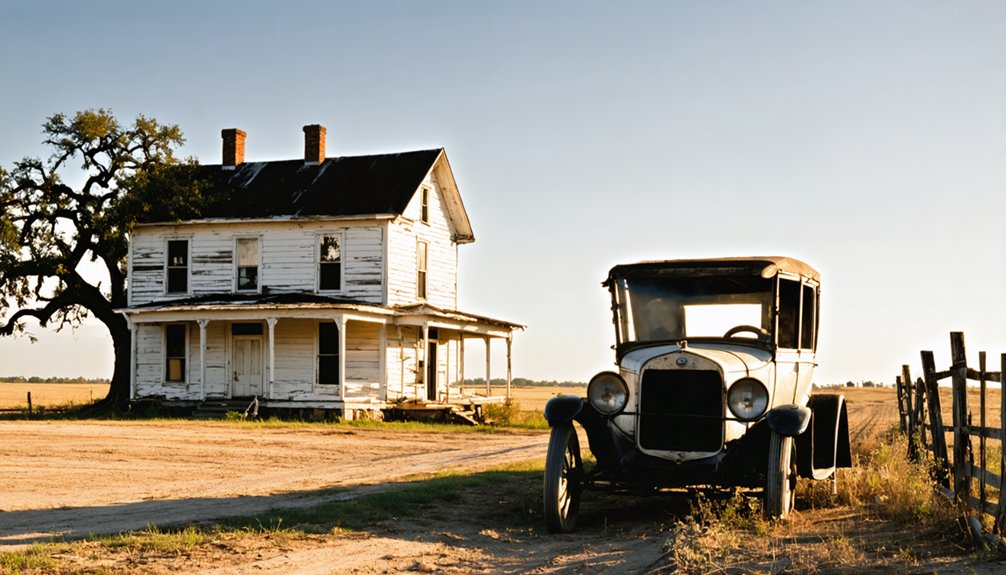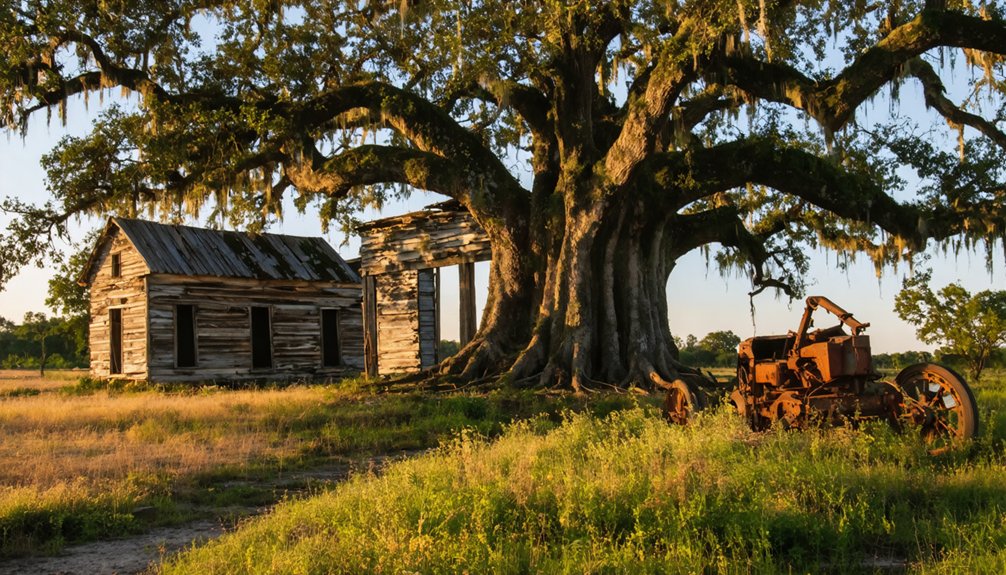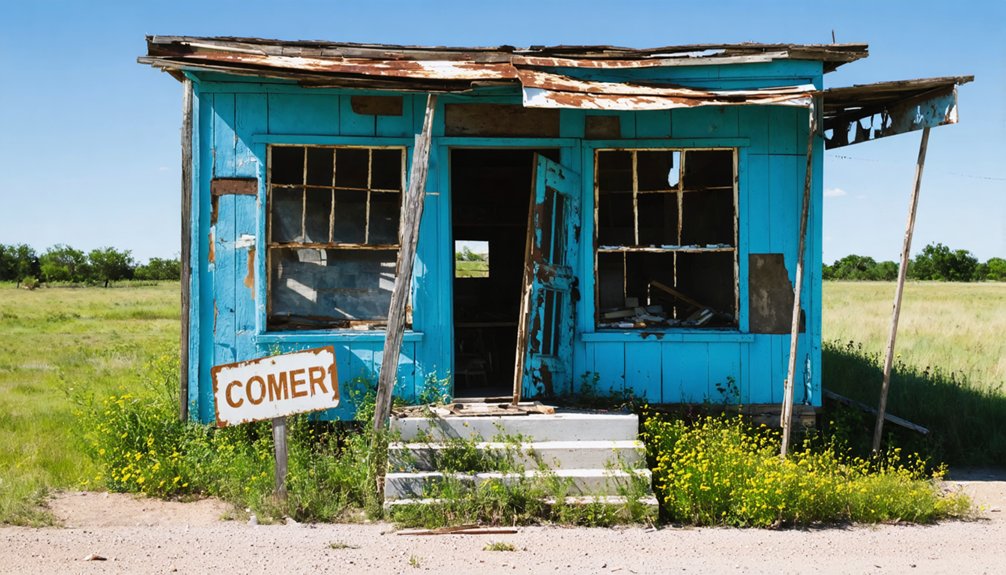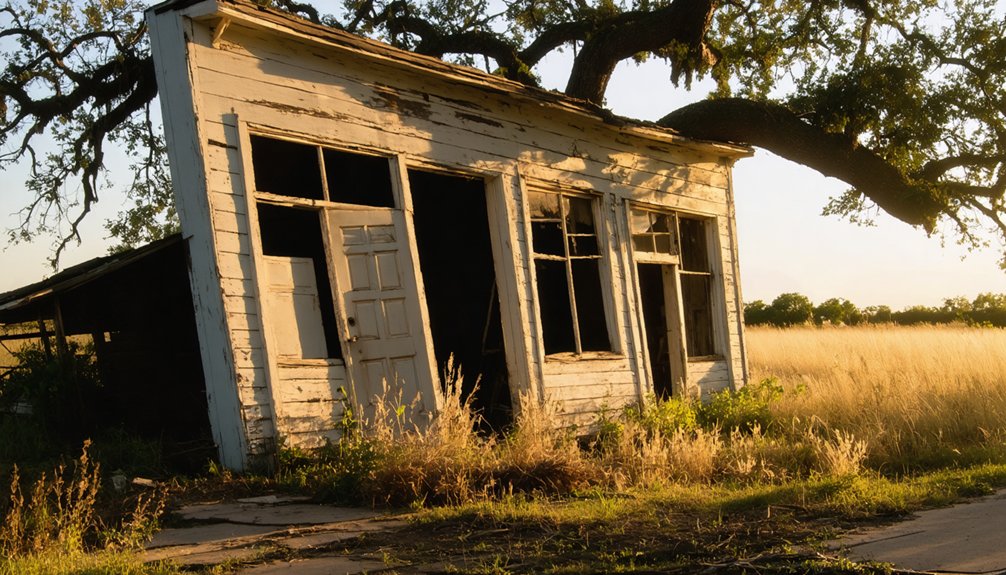You’ll find Lone Oak, Texas along Farm to Market Road 1291, where Czech and German immigrants established Pisek settlement in the 1880s. The town flourished after the Missouri, Kansas and Texas Railroad arrived in 1887, growing from 79 residents to over 1,000 by 1920. Though now a ghost town with only scattered ruins, its centerpiece remains a magnificent oak tree with a 125-foot crown spread, holding secrets of this once-thriving community’s past.
Key Takeaways
- Originally named Pisek in the 1880s, Lone Oak was established by Czech and German immigrants seeking better opportunities in Texas.
- The town flourished after the 1887 Missouri, Kansas and Texas Railroad construction, growing to over 60 businesses by 1914.
- Economic decline led to dramatic business reduction, from 24 establishments in 1945 to just six by 1988.
- The historic site features scattered foundation ruins, grasslands, and the landmark grand oak tree with 125-foot crown spread.
- Located on private property, the ghost town’s population dropped from 1,017 in 1920 to around 50 by 2000.
The Origins of Pisek Settlement
While the present-day town of Lone Oak stands along Farm to Market Road 1291 in Colorado County, Texas, its predecessor Pisek first took root in the 1880s as a settlement of Czech and German immigrants.
You’ll find that these pioneering settlers weren’t just seeking land – they were educated individuals looking for better social, political, and economic opportunities in Texas.
The name Pisek reflects the deep Czech heritage of the area, derived from their word for “sand.” Much like its European namesake that was founded in 1254 by King Ottokar II, the settlement held great promise for its inhabitants.
In this Texas town, the Czech word for sand, Pisek, echoes the cultural roots of its early settlers.
Before adopting this name, you’d have known the settlement as Braden Settlement or simply Bernardo, referencing its location in the Bernardo Prairie area near the San Bernard River.
The settlers arrived around 1845-1846, establishing agricultural practices that would shape the community’s development for generations to come. The community flourished with two stores and a blacksmith shop before 1900.
Railroad’s Impact on Community Development
When the Missouri, Kansas and Texas Railroad constructed its line one mile north of Pisek in 1887, you’d witness a dramatic shift in the community’s center of gravity.
Local businesses swiftly relocated closer to the tracks, where a turntable established essential railroad logistics. Early settlers clearly understood that adequate transportation systems were vital for community survival. By the mid-1980s, the area maintained two stores and eighteen homes. You’d find this move transformed not just the physical layout, but the entire community identity.
The railroad’s influence ran deep, changing everything from postal services to the town’s name. While Pisek became Lone Oak in 1941, the railroad station was dubbed Nickols, reflecting the rail company’s power in shaping local destinies.
Though the community never grew into a major hub, the railway provided crucial connections for residents’ small gardens and stock-raising activities, sustaining the modest settlement through improved market access and transportation links.
Life Before the Name Change

You’ll find that early Pisek settlers established their community around a prominent oak tree at a crossroads in the 1850s, where a post office opened in 1869 to serve the growing Czech and German population.
The arrival of the Missouri, Kansas, and Texas Railroad in 1887, built a mile north of the original settlement, pulled businesses away from Pisek’s core toward the new rail line.
Before the railroad’s construction, Pisek’s residents focused on small-scale agriculture and stock raising, with only two businesses operating near the original town site during the 1880s. The early economy mirrored other areas with its focus on cotton plantation system. The commonality of places named after lone oak trees required geographical disambiguation to distinguish this settlement from others across Texas.
Original Pisek Settlement Layout
Before becoming Lone Oak, the original settlement of Pisek emerged as a modest farming community in Colorado County along what’s now Farm to Market Road 1291, approximately three miles from the Fayette and Austin County lines.
The settlement served primarily German and Czech farmers who established roots in the region. The settlement patterns followed a practical linear arrangement, with a small commercial core serving the surrounding farmland.
You’ll find the community layout was organized around these key features:
- A central cluster of essential buildings, including two stores, a blacksmith shop, and a dance hall
- A post office that operated from 1896 to 1907, serving as the administrative hub
- Agricultural structures like the cottonseed warehouse, reflecting the farming economy
The settlement’s design prioritized accessibility, with residential farms strategically positioned around these crucial community services, creating an efficient rural infrastructure.
Railroad’s Economic Influence
The arrival of railroads in eastern Texas during the 1870s marked a defining chapter in Pisek’s evolution toward becoming Lone Oak. The Texas and Pacific Railway‘s expansion transformed the town into an essential shipping hub, connecting you to larger markets beyond the region’s borders.
You’d have witnessed a dramatic agricultural transformation as local farmers shifted from basic subsistence to commercial farming. The railroad enabled you to ship cotton, grains, and cattle more efficiently than ever before. The new railway system facilitated economic expansion throughout Texas as transportation efficiency improved. The town saw rapid growth when the Missouri, Kansas and Texas Railroad reached the community in 1881.
Steam gristmills and cotton gins sprung up to support this new economy, while the population grew to 800 residents. The rail network didn’t just move goods – it revolutionized your access to credit markets and commercial opportunities, making Lone Oak a thriving center of trade for surrounding agricultural communities.
Community Before Railroad Arrival
While settlers knew it as both Pisek and Sandy Point during the 1880s, this rural community‘s identity centered around a distinctive lone oak tree standing at the intersection of two main roads.
The early settlement mirrored the pattern of other frontier towns that relied on local trade routes between the Gulf of Mexico and San Antonio.
You’d find a self-sufficient community of just 20 residents living off the land through small gardens and livestock raising. The Pisek heritage remained strong from 1869 to 1907, marked by a functioning post office that served as a crucial communication hub.
Life before the railroad was characterized by:
- Two small businesses operating near the main crossroads
- Indefinite boundaries typical of early rural settlements
- A subsistence economy based on local resources and needs
Your ancestors would’ve experienced a tight-knit community where daily life revolved around agricultural routines and basic commerce, independent of outside influences.
The Iconic Oak Tree Legacy

Standing majestically at a key intersection since the 1850s, a single grand oak tree shaped both the identity and name of Lone Oak, Texas.
You’ll find this remarkable tree displaying a perfect mushroom shape, with its massive 25-foot circumference and sprawling 125-foot crown spread dominating the landscape. The oak’s significance runs deep in local oak tree folklore, serving as more than just a landmark – it’s become a living symbol of the community’s identity and resilience.
When businesses relocated near the tree in 1941, the settlement changed its name from Pisek to Lone Oak.
The tree’s enduring presence has made it a frequent subject for photographers and artists, while its ecological importance provides shelter for wildlife in the open Texas prairie.
Population Changes Through Time
You’ll find Lone Oak’s earliest documented population was just 79 residents in 1880, marking the town’s humble beginnings.
The community experienced dramatic growth over the next four decades, reaching its peak population of 1,017 by 1920 – a proof of the economic opportunities that drew settlers to the area.
Following this peak, the town entered a sustained period of decline, with numbers dropping to 726 by 1930 and continuing to decrease through much of the century.
Early Settlement Numbers
The small settlement of Pisek, later known as Lone Oak, experienced significant population shifts tied to railroad development in the late 1800s.
The settlement demographics initially consisted of Czech and German immigrants who established a modest community with just two commercial establishments.
You’ll find that early population numbers remained small but steady enough to support a post office from 1869 to 1907.
Key population milestones include:
- Initial settlement in the 1880s with Czech and German families establishing farms
- Population peak during the railroad era when businesses clustered near the Missouri, Kansas and Texas Railway
- Decline to approximately 20 residents by 1939, though the community later stabilized around 50 people by 2000
Population Peak and Decline
Since its early days as Pisek, Lone Oak experienced dramatic population shifts that culminated in a remarkable peak of 1,017 residents by 1920.
You’ll find the town’s most significant demographic shifts occurred between 1880 and 1920, with the population soaring from just 79 to over a thousand residents.
The town’s population trends took a sharp downturn after 1920, dropping nearly 29% by 1930.
You can track the decline through the mid-century, when numbers fell to 495 by 1960.
While brief rebounds appeared in the 1970s and 1990s, with the population hovering around 520, these didn’t approach the historic peak.
Recent years have shown modest growth, with 643 residents recorded in 2020 and estimates reaching 742 by 2022.
Economic Activities and Local Business

During its economic heyday, Lone Oak flourished as an essential agricultural shipping hub, boasting more than 60 businesses by 1914.
You’d find a bustling town that thrived on agricultural trends, with steam gristmills and cotton gins processing local crops. The Missouri, Kansas and Texas Railroad‘s arrival in 1881 transformed the town into a crucial transport center, connecting farmers to larger Texas markets.
Steam gristmills churned and cotton gins whirred as Lone Oak transformed into a vital railroad hub for Texas farmers.
- Two banks and three churches served the community at its peak
- Local businesses included retail stores and agricultural service providers
- By 1945, business decline reduced the number of establishments to 24
As transportation shifted from rail to highways, Lone Oak’s economic significance waned. The Great Depression and World War II accelerated the town’s downturn, and by 1988, only six businesses remained operational.
From Pisek to Lone Oak: A Town’s Journey
Located in northern Colorado County, Pisek emerged as a vibrant Czech and German immigrant settlement in the late 19th century, though you’d know it better today as Lone Oak.
You can trace the town’s Pisek heritage along the BNSF Railway crossing at Fischer-Buller Road, where it once thrived between Fayetteville and New Ulm.
The town’s journey from Pisek to Lone Oak history marked a significant change after 1941.
When residents faced changing economic conditions and shifting rail patterns, they didn’t surrender their community – they relocated nearby, establishing Lone Oak.
While the original settlement became a ghost town, the community’s spirit lived on through this strategic move, preserving their cultural identity and adapting to new realities in post-World War II rural Texas.
Modern Day Remnants and Landmarks

Today’s visitors to Lone Oak will find few traces of the once-bustling community, with an inscribed stone in the Huff Family cemetery standing as the primary physical reminder of the former townsite.
Modern accessibility is limited since the ghost town lies on private property, and you’ll need permission to explore beyond the cemetery. The surrounding landscape has returned to its natural state, with open grasslands and wooded areas typical of Caldwell County.
For those interested in ghost town tourism, here’s what remains:
- The historic Huff Family cemetery with its commemorative marker
- Rural countryside that’s reverted to pasture and ranch land
- Scattered foundation ruins hidden beneath natural vegetation
While nearby highways bypass the site, the untouched landscape preserves the authentic ghost town atmosphere that draws history enthusiasts.
Historical Significance in Texas Ghost Towns
While many Texas ghost towns emerged from dramatic boom-and-bust cycles, Lone Oak represents a different historical pattern that shaped the state’s rural landscape.
You’ll find in Lone Oak’s story a more gradual decline that mirrors countless small Texas settlements, where shifting transportation routes and modest economies couldn’t sustain growth.
Unlike mining boomtowns, this former Pisek heritage site relied on small-scale retail and local farming, making it particularly vulnerable to change.
When the railroad’s influence waned and the town’s postal service closed in 1907, Lone Oak began its slow transformation into what ghost town tourism experts classify as a “semiabandoned” community.
Frequently Asked Questions
Are There Any Supernatural Legends or Ghost Stories About Lone Oak?
You’ll find haunted history centered on “Annie” who appears in the Texas park section, while local folklore tells of spectral women wandering at midnight near the old Huff Family cemetery.
What Happened to the Original Families Who First Settled in Pisek?
You’ll find some Pisek settlers moved back to the original settlement, others scattered to new locations, but most family legacies remain unclear since historical records don’t track their descendants’ paths.
Did Any Famous Historical Figures Ever Visit or Stay Here?
You won’t find records of any historical visits or notable travelers stopping in this small frontier settlement – no famous figures left their mark on the town’s documented past.
Why Wasn’t the Town Relocated Closer to the Railroad Tracks?
Like roots anchoring an oak tree, the community’s historical significance kept them near their original settlement, despite transportation logistics favoring relocation. They’d built lives and weren’t ready to uproot for railroad convenience.
How Old Is the Iconic Oak Tree That Gave the Town Its Name?
You can’t determine the iconic tree’s exact age, but since it was a landmark by the 1880s and named the town in 1941, it’s likely at least 100+ years old.
References
- https://mix931fm.com/cherokee-county-ghost-towns/
- https://kids.kiddle.co/Pisek
- https://www.tshaonline.org/handbook/entries/lone-oak-tx-colorado-county
- https://www.kut.org/texas/2017-10-30/boo-the-rise-and-fall-of-texas-ghost-towns
- https://en.wikipedia.org/wiki/List_of_ghost_towns_in_Texas
- https://www.texasescapes.com/CentralTexasTownsSouth/Lone-Oak-Texas.htm
- https://www.texasescapes.com/CentralTexasTownsNorth/Lone-Oak-Texas.htm
- https://en.wikipedia.org/wiki/Pisek
- http://www.fayettecountyhistory.org/communities3.htm
- https://placeandsee.com/pisek-texas-united-states



